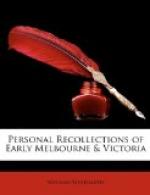Sweeping now round to the west side we come to the good store and residence belonging to J.F. Strachan, of Geelong, and managed by F. Nodin, who was quite a character of the time, with his bustling form, and face ever full of business, whether business were full or not. He would always accept his bills in red ink, and, as the joke goes, the bills being good, the Nodin manner was supposed to help even the non-Nodin bills through at the “Australasia.” At the corner opposite the Shakespeare was the Melbourne Auction Company, where I first met my most worthy old friend, George Sinclair Brodie, so well known for ten years after as the leading Melbourne auctioneer, or rather “broker,” for that is nearer the home equivalent. He was the salesman, while a genial and amusing good fellow, John Carey, from Guernsey, was manager. The company had just paid 20 per cent dividend—the first as well as the last in that way. In the jolly days up to that time every buyer got credit, and there was plenty of business; but when the times changed the credit bills were not met, and so the poor M.A.C., which had as usual guaranteed them, got cleaned out.
Down Collins-street once more, we pass the primitive wooden cottage residence of Mr. and Mrs. Smith, whose family of fine daughters were already all married—Mrs. D.S. Campbell, Mrs. R. Russell, Mrs. Martin, Mrs. Hutton—excepting the youngest, then a school-girl, afterwards married to Nantes, of Geelong, D.S. Campbell’s partner. Then came Craig and Broadfoot’s stores, and Alison and Knight’s flour mills. At the end was pretty green Batman’s Hill, which has since been remorselessly sacrificed for the great railway terminus. Batman’s original wooden house on the southern slope was, after his early death, occupied as the Government offices by Mr. La Trobe, and this homely tenement did such high duties for no small subsequent term. Down hereabout was also a conspicuous line of five little wooden cottages, called Roach-terrace, after Captain Roach, another very early colonist, which were each let at 5 pounds a week, although they would not have brought half that money by the year at home. Returning on the other side was St. James’s Church, in charge of the Reverend Mr. Thomson, of most sociable memory, within its ample open area, and, further on, the notorious Lamb Inn.
For the rest of Melbourne of 1840 I must be content with one general sketch. Manton’s Mills had arisen at the lower end of “the wharf,” such as it then was. Flinders-street had as yet but little in it. James Jackson, afterwards Jackson, Rae and Company, was already there. About the middle was the cottage of P.W. Welsh, prior to his removing to South Yarra; and there, as the story goes again, Mrs. Welsh gave her “Five Hundred Pound Party,” but having unfortunately omitted Arden, the editor of the “Gazette”, in the invitations, he was left free to denounce so bad an example of extravagance. Bourke-street had an incongruous grouping, including the well-known




